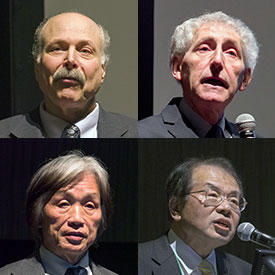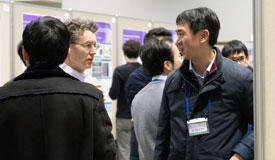

03/26/2018
Following Tohoku University’s selection by the Japanese government as a Designated National University in June 2017, plans are afoot to create world-leading research centers that will enhance the university’s already formidable reputation in four vital areas: materials science, spintronics, next-generation medical care and disaster science. In collaboration with several other institutes and departments at the university, the Advanced Institute for Materials Research (AIMR) will play a key role in developing the new materials science center.

To stimulate interdisciplinary dialogue and idea sharing, the Kick-off Symposium for World Leading Research Centers — the first event of its kind, being jointly organized by materials science and spintronics groups — was held in Sendai on 19–20 February 2018. It brought together top minds from Tohoku University and internationally, as well as industry partners.
In his welcome address, Susumu Satomi, president of Tohoku University, spoke of the honor of being selected as a Designated National University alongside the University of Tokyo and Kyoto University. He highlighted the importance of strengthening research under this new framework and providing the best possible working conditions in the light of increasing global competition.
Representing Japan’s Ministry of Education, Culture, Sports, Science and Technology (MEXT), Masanori Shinano, deputy director-general of the Higher Education Bureau, conveyed his aspirations for “advancing research that will be a force for innovation and actualization of Society 5.0.” Outlined in Japan’s Fifth Science and Technology Basic Plan in 2016, Society 5.0 aims to transform society through the widespread adoption of artificial intelligence, big data, robotics and the Internet of Things (IoT).
Continuing on the theme of Society 5.0, Kazuo Kyuma, an executive member of Japan’s Council for Science, Technology and Innovation, explained that “integrating cyberspace and physical space will be key to creating new values in industry and social systems” and novel materials will be indispensable to realizing this so-called Super Smart Society.
Kyuma expressed his confidence in the AIMR under the leadership of Director Motoko Kotani, highlighting its accomplishments in the areas of metallic glasses, porous materials and spintronics materials. He commended the impressive advances in spintronics by Hideo Ohno, director of the Research Institute of Electrical Communication (RIEC) as well as principal investigator at the AIMR, and Tetsuo Endoh, director of the Center for Innovative Integrated Electronic Systems (CIES).
In her opening remarks, Kotani referred to Tohoku University’s more than century-long history of excellence in researching materials. It extends back to the founding of the Institute for Materials Research (IMR) in 1916 and the work of the institute’s first director Kotaro Honda, who is renowned for his development of permanent magnet steels. It also includes the establishment of the Institute of Multidisciplinary Research for Advanced Materials (IMRAM) in 2001 and the AIMR in 2007.
Building on this rich history of research, the AIMR is exploring materials science by harnessing the power of mathematics, Kotani noted. She emphasized the importance of “forging strong international ties through a global alliance network, consolidating research capabilities at a university-wide level, focusing on research that addresses the needs of society, and working toward the United Nations’ Sustainable Development Goals.”
Speaking in his capacity as RIEC director, Hideo Ohno, who will become the president of Tohoku University from April 2018, also reflected on the university’s rich past. He drew attention to the work of Junichi Nishizawa, a pioneer in semiconductor research, and Shunichi Iwasaki, the inventor of perpendicular magnetic recording, a technology used globally in hard disks.
“Spintronics is a field that inherits and combines these early achievements,” he said. Now spanning materials science, condensed-matter physics, device engineering and system applications, spintronics will be foundational for realizing Society 5.0, he added.
In a special message, Dan Shechtman, who was awarded the Nobel Prize in chemistry in 2011 for his work on quasicrystals, extended his congratulations to Tohoku University and expressed his hopes for young scientists to continue contributing to the university’s outstanding achievements.
Presentations in six sessions began with plenary talks covering an array of new developments in spintronic technologies, mathematics, and computational and materials science.

David Awschalom of the University of Chicago explained that, in contrast to the conventional goal of removing defects from devices, his team is “putting defects back into quantum systems to explore new electronic and optical technologies.” For example, embracing defects in silicon carbide to achieve a new level of control over spin dynamics could profoundly impact quantum information processing and medical imaging.
In his talk titled ‘Taking Mathematics to Heart’, Alfio Quarteroni of Politecnico di Milano, Italy, and the École Polytechnique Fédérale de Lausanne (EPFL), Switzerland, described how numerical simulations can be used to model systems even as complex as the human heart. Running simulations of healthy and unhealthy hearts, he said, could help doctors diagnose cardiovascular disease and determine better treatment plans. He added that mathematical models are providing insights into fields as diverse as seismology and sports science.
Representative director and chairman of Renesas Electronics Corporation, Tetsuya Tsurumaru, stated: “Spintronics has the highest possibility of providing solutions to emerging technological demands.” Acknowledging the top-level spintronics research conducted at Tohoku University, he stressed the importance of strengthening mutual cooperation. “Semiconductors have the power to change the world,” Tsurumaru said. The challenges ahead will be to “cultivate global human resources and encourage open innovation,” he added.
Renowned inventor Masato Sagawa, now a consultant at Daido Steel Co, Ltd, presented his work on the development of neodymium−iron−boron sintered magnets, for which he was awarded the Japan Prize in 2012. Referring to his studies at and later collaborations with Tohoku University, he noted that “the contribution of Tohoku University, especially that of the IMR, was overwhelmingly important in the evolution of the world’s strongest permanent magnets.” He indicated that the most promising applications for these magnets will be robots and electric vehicles, and concluded by proposing that the coming era of cleaner technologies based on light rare-earth elements such as neodymium be termed the Rare-Earth Iron Age.
In her presentation, after a brief introduction to the World Leading Research Center for Materials Science, Kotani gave an overview of the AIMR’s activities so far and described her own expertise in geometrical analysis. She shared her vision for a collaborative way forward, which will be critical to achieving “new research objectives with increasing global relevance, including the development of highly efficient energy conversion and storage systems based on functional materials, and reliable social infrastructure systems based on structural materials.”
Kotani explained that the AIMR’s three target projects have already proved fruitful, and said that mathematics as a common language is “helping to visualize, quantify and conceptualize data” to deepen our understanding of materials science.
On the university’s new status, Kotani commented: “We are proud to be selected as a focus research center and more than happy to be a role model to transfer the know-how we have developed to achieve world premier status in the WPI program to other research centers.” The AIMR, she adds, will aim to “maintain top-level research in its capacity as a member of the newly established WPI Academy and play a central role in Tohoku University’s new materials science research center.”
As the final plenary speaker, Ohno presented his work on nanospintronics devices for artificial intelligence and very large-scale integration. The ideal technology for working memory, he suggested, is a “non-volatile memory that is scalable and fast and has virtually infinite endurance.” Spintronic memory devices, he averred, are the only ones known to be capable of achieving this ideal.

Ohno noted that scalability is one of the top priorities for industry to realize a wide variety of applications for artificial intelligence and that this aspect makes materials so crucial. The coming challenges, he said, will be to “deepen knowledge and transfer it to the real world and provide an R&D platform for cutting-edge technologies.”
In total, 373 people took part in the two-day symposium, including 15 invited speakers, and 183 posters were displayed at Sendai International Center.

The symposium was followed by the AIMR Workshop 2018 on 21 February, which provided another opportunity for researchers at the AIMR, its joint research centers and overseas partner institutions to interact. Held annually since 2008, the workshop is a continuation of the AIMR International Symposium (AMIS), which aims to stimulate further research exchange and international networking at the AIMR through providing a forum for discussions from various angles.